Physical Address
304 North Cardinal St.
Dorchester Center, MA 02124
Bacillus anthracis toxins
Anthrax is a fatal disease in domestic livestock and in wild herbivores.
Humans are usually infected incidentally.
Most human disease is cutaneous, followed by oral–oropharyngeal, gastrointestinal, and inhalational.
Disease is mediated through toxins that cause edema, hemorrhage, and necrosis.
Mortality rate is high.
Diagnosis is clinical, biopsy, Gram stain, culture, or serology.
Treatment is with penicillin, ciprofloxacin, tetracycline, erythromycin, chloramphenicol, or streptomycin.
Prevention is via vaccination or quarantine of animals and avoidance / destruction of contaminated animal products.
Anthrax is found throughout tropical Africa, Asia, and Central and South America as well as the Caribbean; it is due to the Gram-positive bacillus Bacillus anthracis . Incidental infection of humans is usually due to contact with infected livestock, wild herbivores, or animal products (e.g., meat, hides, wool). Dying and dead animals contaminate the soil with spores that subsequently infect other animals or humans. Recently the potential of the use of anthrax spores as weapons of bioterrorism has become a reality.
Over 95% of all clinical anthrax is cutaneous, resulting from spores entering the body through the abraded skin of persons skinning or butchering infected animals, or persons subsequently handling the meat, hides, or wool. If untreated, 80% of the cutaneous infections become localized and 20% develop bacteremia and fatal septicemia.
Other presentations of anthrax include oral–oropharyngeal or gastrointestinal (from eating raw or undercooked meat) and inhalational (from contaminated wool or hides, or from bioterrorism). The majority of these systemic presentations are fatal if not treated. Hematogenous spread can lead to meningoencephalitis. Death is from edema, hemorrhage, and necrosis secondary to anthrax toxins.
Anthrax spores can survive for years in dry soil and in other harsh environments. When these spores come into contact with wild animals or livestock then epidemics of anthrax can result, as was the case in Zimbabwe from 1978 to 1982. Anthrax spreads to animals and humans from contaminated soil and from animal carcasses, but also from the bites of tabanid flies (e.g., horse flies and deer flies). Although most human cases of anthrax have been reported from Africa, southern Europe, and the Middle East, anthrax in livestock is reported regularly from west Texas to South Dakota. Although such cases in livestock can affect ranchers, butchers, and others who work with cattle, such reports are uncommon in the USA.
Persons who work with animal products such as hides in the textile industry and tanneries have been infected with anthrax, resulting in the majority of cases reported in the USA in the 20th century being industry related. In recent decades, however, such cases have become rare owing to the strict controls on animal products as well as the increasing use of synthetic fabrics.
In the 20–21st centuries, anthrax has been used as a weapon in isolated cases of bioterrorism. The accidental release of anthrax in 1979 from a biological weapons facility in Sverdlovsk (now Ekaterinburg), Russia resulted in significant mortality in humans and in livestock.
After entering the skin, anthrax spores germinate, resulting in a “malignant pustule,” although pus is usually seen only if there is a secondary bacterial infection. Histology of the skin lesions reveals marked tissue destruction with extensive subepidermal edema, thrombosis of vessels, and hemorrhagic interstitium. Toxin production results in generalized edema and non-pitting edema around the lesion. Although the draining lymph nodes respond to the infection, the bacterial capsule is antiphagocytic and bacteremia often results.
Inhalation anthrax results in phagocytosis of spores by alveolar macrophages, mediastinal widening, and bacteremia. As seen in the victims in Sverdlovsk, death is due to primary pneumonia. Interestingly, anthrax is not found in the sputum in inhalation anthrax.
Ingestion of meat contaminated with anthrax results in ulceration and hemorrhage at the points of entry in the submucosa, especially in the oropharynx and the ileocecal regions. Hemorrhagic ascites and diseased bowel segments are associated with bacteremia. Hemorrhagic meningitis can result from bacteremia in any clinical form of anthrax.
Although reinfection with anthrax has been reported, immunity can develop from subclinical infection, and lasting protection usually results in survivors of clinical anthrax. Measurable antibodies to the toxin and the capsule are found after infection. Anthraxin is a skin test for delayed-type hypersensitivity that has been reported to be useful.
In humans, clinical anthrax presents in one of three forms: cutaneous, inhalational, and oral–oropharyngeal / gastrointestinal. Over 95% of cases, however, are cutaneous. In approximately 90% of cases, there is only one lesion, and it is usually on an exposed part of the body. The initial symptom is pruritus, which follows infection by 3–10 days. The first sign, a papule a few millimeters in diameter, usually follows pruritus by only 1 day. During the next day, vesicles develop which surround the papule ( Fig. 28-1 ). The vesicles coalesce and the papule ruptures, resulting in a 4–6 cm ulcer ( Fig. 28-2 ). During the next few days the ulcer develops a thick, depressed, brown to black eschar that is adherent to the underlying tissue ( Figs. 28-3 and 28-4 ). Non-pitting edema forms around the eschar and regional lymphadenopathy develops. If the lesion is on the neck, edema may become so extensive as to compromise respiration. The patients are usually afebrile and the skin lesions are usually painless. Some patients, however, do develop fever, headache, anorexia, nausea, and lethargy associated with the systemic effects of the toxin. Meningitis and periorbital cellulitis have also been reported.
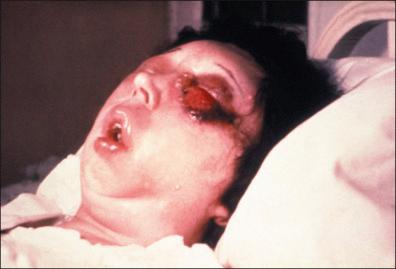
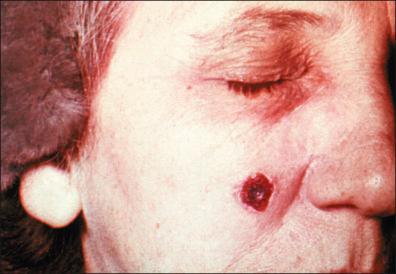
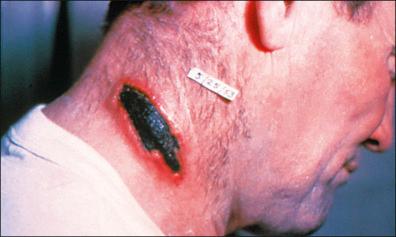
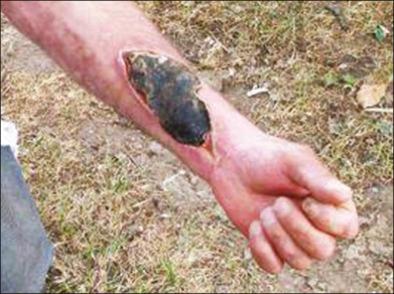
Over 80% of untreated cutaneous lesions remain localized and heal within 2–6 weeks, often resulting in scar formation. Almost 20% of untreated cutaneous lesions and the majority of systemic infections develop systemic bacteremia and are fatal.
In the setting of the signs and / or symptoms of anthrax and / or a history of (potential) exposure to the bacteria or spores, a Gram stain should be carried out on material from the vesicle fluid, ulcer base, or other appropriate clinical material for large, Gram-positive bacilli. Bacterial culture should be inoculated on the appropriate medium and serology performed using a specific inhibition enzyme immunoassay for antibodies directed against purified protective antigen. A biopsy should be taken from a characteristic cutaneous lesion and examined for the changes described above. Therapy must be initiated immediately to prevent the high rate of mortality and to reduce morbidity.
The differential diagnosis of cutaneous anthrax includes orf, staphylococcal skin lesions such as bullous impetigo, tularemia, plague, burns, cutaneous diphtheria, rickettsial eschar, and ecthyma gangrenosum.
Considering the high mortality rate of anthrax, treatment must be started as soon as possible. Therapy of cutaneous anthrax is usually with oral potassium penicillin V or intramuscular procaine penicillin G. If the patient has a penicillin allergy, alternatives include tetracycline, ciprofloxacin, erythromycin, streptomycin, or chloramphenicol. Intravenous penicillin G along with intensive supportive care is the therapy of choice for systemic anthrax. Penicillin resistance, has been reported ; however, new therapies are under development. Surgical excision or incision of the cutaneous lesions is not beneficial and can even exacerbate the injury.
Use of control measures for animal anthrax will help prevent human anthrax. These measures include quarantine of animals suspected to have been exposed to anthrax, use of antibiotics, or destruction and incineration of infected animals and vaccination of livestock at risk for anthrax. Prevention of human anthrax also requires public awareness programs and vaccination for persons at high risk (e.g., the military). Enhanced understanding of the immune response to anthrax and improved technologies are leading to new and safer vaccines. Antibiotic prophylaxis can be protective if used properly.
Yersinia pestis, bubonic plague, septicemic plague, pneumonic plague
Plague is a zoonotic infection in rodents and is transmitted by fleas.
Plague is due to a non-motile, non-sporulating, Gram-negative coccobacillus, Yersinia pestis .
Without therapy, most cases of bubonic plague and almost all cases of septicemic and pneumonic plague are rapidly fatal.
Plague is found in the western USA, in parts of South America, in southern Africa, and in eastern and southern Asia.
Therapy is with aminoglycosides, fluoroquinolones, or doxycycline.
No vaccine is available, but control is by avoidance of areas with epizootic plague and control of fleas with insecticides.
For many centuries plague has appeared in epidemics, with significant mortality rates. Due to the understanding of the epidemiology of plague and the responsible organism, Yersinia pestis , control of the responsible rodents and fleas has markedly decreased the incidence of this infection. The availability of antibiotics in the second half of the 20th century has allowed effective therapy of plague if the signs and symptoms are recognized in a timely manner.
Although there are biblical references to “plagues,” it was not until 542 ad that a pandemic due to plague (i.e., Y. pestis ) was described. It lasted 100 years and devastated the populations of the Mediterranean and the Middle East. Following the increase in the rat population, the next recorded pandemic lasted from 1347 to 1350, resulting in 25 million deaths, approximately 25% of Europe. It was referred to as the “black death,” possibly due to a hemorrhagic diathesis in some patients. Pandemics were subsequently recorded in London in 1665 and in the Far East in the late 19th century. By 1903 India was experiencing over 1 million deaths annually due to plague. The infection made its appearance in the western hemisphere in Santos, Brazil, in 1899 and in the USA (in San Francisco) in 1909. The last epidemic of pneumonic plague was in Berkeley Hills, California, in 1919. With the increased understanding of the epidemiology of plague in the late 19th century and the discovery of the responsible organism by Alexander Yersin in 1894, better control of the wild rodent population and rat-proofing of buildings and ships resulted in marked decreases in plague in the western hemisphere by the 20th century.
About 15 countries report plague to the World Health Organization (WHO) each year. These cases are primarily from the western USA, Peru, East Africa, Southeast Asia, and India. A median of three cases per year was reported in the USA at the beginning of the 21st century, but 11 cases were reported in 2015. Y. pestis exists in nature as a zoonotic infection in rodents and their fleas, and humans are incidentally infected, usually by flea bites and occasionally by handling infected animals or by inhalation.
After gaining entrance into the body via a flea bite or inhalation, the organism causes bacteremia and septicemia, leading to death by disseminated intravascular coagulation (DIC), refractory hypotension, renal shutdown, and shock. Pneumonic plague results in acute respiratory distress syndrome (ARDS) and multilobar confluence.
Bubonic plague is the most common presentation and accounts for 80–85% of cases. Following the bite of an infected flea, one or more lymph nodes swell, resulting in painful “buboes.” In 10% of cases septic plague, which has no localizing signs, results from a flea bite or direct contact with infectious fluids. In 3% of cases primary pneumonic plague results from inhalation of infectious droplets and develops into a fulminant primary pneumonia.
Approximately 2–6 days after infection, the patient with bubonic plague experiences fever (up to 38°C or greater), chills, headache, myalgias, arthralgias, and lethargy. During the next day or two the patient suffers pain and tenderness in the regional lymph nodes draining the area of the flea bite. The bite often results in a papule, pustule, ulcer, or eschar ( Fig. 28-5 ). The skin over the involved lymph nodes becomes erythematous, edematous, tense, and warm to the touch. The bubo of plague ( Fig. 28-6 ) differs from the lymphadenopathy of most other etiologies by its rapid onset, marked tenderness, and systemic toxemia as well as the absence of cellulitis or ascending lymphangitis.
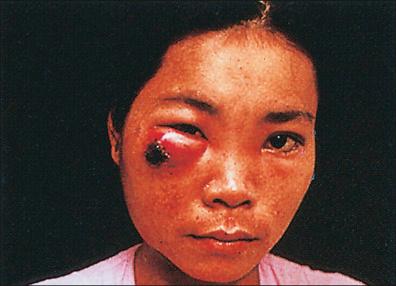
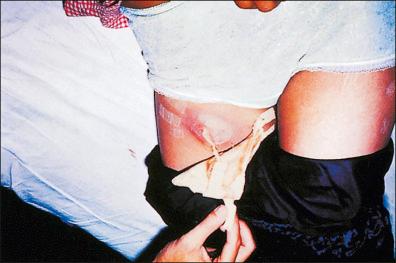
If appropriate antibiotic therapy is initiated in the acute state, bubonic plague usually responds rapidly, with decrease of fever and resolution of systemic symptoms in 2–5 days. The buboes, however, remain enlarged, tender, and sometimes fluctuant for 1 week or longer after successful therapy.
If therapy is not initiated acutely, bubonic plague progresses to systemic toxemia, tachycardia, prostration, agitation, confusion, convulsions, delirium, and death.
Become a Clinical Tree membership for Full access and enjoy Unlimited articles
If you are a member. Log in here